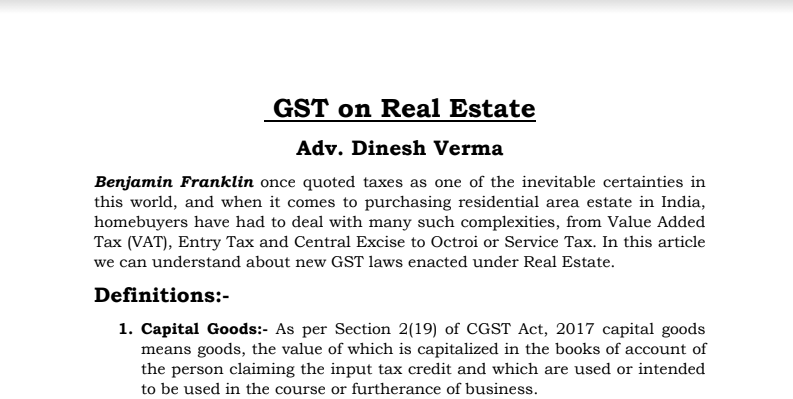GST on Real Estate
GST on Real Estate
Benjamin Franklin once quoted taxes as one of the inevitable certainties in this world, and when it comes to purchasing residential area estate in India, homebuyers have had to deal with many such complexities, from Value Added Tax (VAT), Entry Tax and Central Excise to Octroi or Service Tax. In this article, we can understand about new GST laws enacted under Real Estate.
Definitions:-
1. Capital Goods:- As per Section 2(19) of CGST Act, 2017 capital goods means goods, the value of which is capitalized in the books of account of the person claiming the input tax credit and which are used or intended to be used in the course or furtherance of business.
2. Services:- As per Section 2(102) of CGST Act, 2017 services means anything other than goods, money, and securities but includes activities relating to the use of money or its conversion by cash or by any other mode, from one form, currency or denomination, to another form, currency or denomination for which a separate consideration is charged.
3. Input:- It means any goods other than capital goods used or intended to be used by the supplier in the course or furtherance of business.
4. Input Service:- It means any service used or intended to be used by a supplier in the course or furtherance of business.
5. Input Tax:- In a relation to a registered person, means the central tax, State Tax, integrated tax or Union territory tax charged on any supply of goods or services or both made to him and includes-
(a) The integrated goods and services tax charged on import of goods;
(b) The tax payable under the provisions of sub-sections (3) and (4) of section 9;
(c) The tax payable under the provisions of sub-sections (3) and (4) of section 5 of the IGST Act;
(d) The tax payable under the provisions of sub-sections (3) and (4) of section 9 of the respective SGST Act;
(e) The tax payable under the provisions of sub-section (3) and (4) of section 7 of the UTGST Act, But does not include tax paid under the composition levy.
6. Reverse Charge:- It means the liability to pay tax by the recipient of supply of goods or services or both instead of the supplier of such goods or services or both under sub-section (3) or sub-section (4) of section 9, or under sub-section (3) or sub-section (4) of section 5 of the Integrated Goods and Services Tax Act.
7. Works contract:- It means a contract for building, construction, fabrication, completion, erection, installation, fitting out, improvement, modification, repair, maintenance, renovation, alteration or commissioning of any immovable property wherein transfer of property in goods (whether as goods or in some other form) is involved in the execution of such contract.
8. Immovable Property:- It shall include land, benefits to arise out of the land, and things attached to the earth, or permanently fastened to anything attached to the earth.
Taxes before GST implementation
Before the GST came into force, a variety of state and central taxes were imposed on the building, through the course of the construction of a housing project. While these taxes increased the cost of project development for developers, no credit against this tax was available to the builders against the output liability. Some of the taxes that real estate developers had to pay before the GST came into force included Value Added Tax (VAT), Central Excise, Entry Tax, LBT, Octroi, Service Tax, etc. The cost incurred on these taxes by builders was then transferred to the property buyer. Moreover, as buyers had very little clarity over the various taxes and the applicable rates, developers were also in a position to manipulate numbers, to keep the deal to their best advantage. For a common buyer, it would have been an uphill task, to find out the VAT, Central Excise, Entry Tax, LBT, Octroi, and Service Tax rate applicable on property construction.
After GST implementation
With much fanfare, the GST regime was launched in India on July 1, 2017. Touted to be the biggest tax reform in India after independence, the GST subsumed multiple indirect taxes, to offer a uniform regime to the taxpayer. Initially, the GST for real estate was kept higher but the Narendra Modi – led government, which launched the revolutionary tax regime, reduced the rates in 2019. This was done, in a bid to make properties more affordable to the common man and to boost its ambitious ‘Housing for All by 2022’ target.
GST rates before 1st April 2019
On affordable housing projects:- 8% with Input Tax Credit.
Other than affordable housing projects:- 12% with Input Tax Credit.
GST Rates from 1st April 2019
On Affordable housing projects;- 1% with Input Tax Credit.
Other than Affordable housing projects:- 5% with Input Tax Credit.
Applicability of new GST Rates
The new tax rates shall be applicable as follows:-
1. 1% of ITC on the construction of affordable houses shall be available for:
i) Houses having an area of 60 sqm in non-metros/ 90 sqm in metros and value up to Rs. 45 lakhs.
ii) Under construction affordable houses presently eligible for a concessional rate of 8% GST (after 1/3rd land abetment).
2. 5% without ITC shall be applicable on the construction of :
i) Under construction houses other than affordable houses presently booked prior to or after 01.04.2019. For houses booked prior to 01.04.2019, a new rate shall be available on installments payable on or after 01.04.2019.
ii) Commercial apartments having carpet area of not more than 15% of the total carpet area of all apartments.
Before and After Amendment GST Rates under construction
1. Construction of affordable residential apartments by a promoter in an RREP/REP.
Before April 20 – 12% (after 1/3rd abatement allowed for land value), with full ITC.
After April 20 – 1% and no ITC
2. Construction of residential apartments other than affordable residential apartments by a promoter in RREP/REP.
Before April 20 – 12% (after 1/3rd abatement allowed for land value), with full ITC.
After April 20 – 5% and no ITC
3. Construction of commercial apartments (shops, offices, godowns, etc.) by a promoter in an RREP.
Before April 20 – 12% (after 1/3rd abatement allowed for land value), with full ITC.
After April 20 – 5% and no ITC
4. Construction of commercial apartments (shops, offices, godowns etc.) by a promoter in REP.
Before April 20 – 12% (after 1/3rd abatement allowed for land value), with full ITC.
After April 20 – 12% (after 1/3rd abatement allowed for land value), with full ITC.
Conditions of New Tax Rates
a) No Input Tax Credit.
b) Reverse ITC should be based on carpet Area for the supply of construction services.
c) 80% of the value of inputs and inputs services other than TDR, Electricity, HSD, Motor Spirit, and Natural Gas should be purchased from a registered supplier.
d) Total ITC to be shown as Ineligible ITC in GSTR 3b every month.
e) RCM should be charged on two rates:-
i) 18% – for all inputs and input services.
ii) 28% – for cement.
Conclusion
From the above details, it is clear that the benefit of the proposed GST of 5% restricting the input tax credit would be beneficial to only those projects which have a high rate per square feet on account of increased land price and has a negative impact or no impact where the flat price is less on account of reduced land price. Rationalization of tax rates would not only boost the sales for the real estate sector but also allow the benefits to reach the ultimate consumers.
However, any restriction on input tax credit would result in a massive cascading effect of taxes and lowering of profits for the industry. This move has resulted against the basic principle of GST which was to establish an unbroken chain of tax credits. Reversal of Input tax credit on a proportionate basis would entail significant computational issues for builders as each project would be in various stages of construction and have different sale patterns. Protecting existing input tax credits and mandating the new rates only in respect of new projects would benefit both builders and consumers.
 Advocate Dinesh Verma
Advocate Dinesh Verma


















